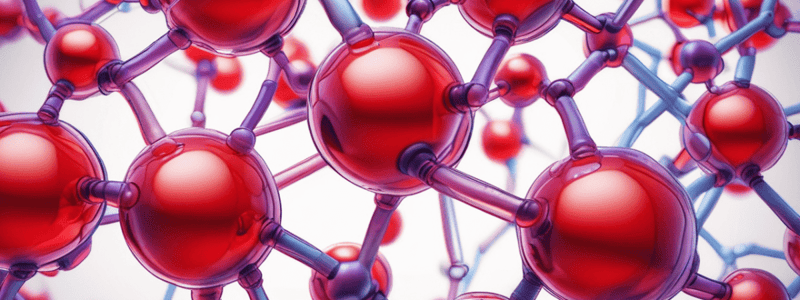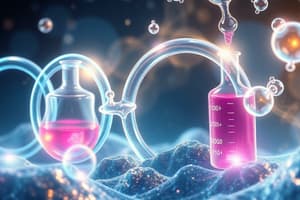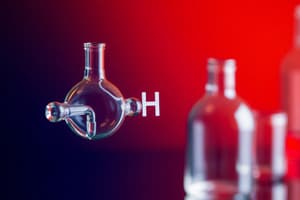Podcast
Questions and Answers
What is the general molecular formula for alkanes?
What is the general molecular formula for alkanes?
- CnH2n+2 (correct)
- CnH2n+1
- CnH2n
- CnH2n-2
Which type of hydrocarbon contains at least one carbon–carbon triple bond?
Which type of hydrocarbon contains at least one carbon–carbon triple bond?
- Alkynes (correct)
- Alkanes
- Arenes
- Alkenes
What is the name of the alkyl group derived from CH4?
What is the name of the alkyl group derived from CH4?
- Ethyl
- Propyl
- Isopropyl
- Methyl (correct)
What is the name used to identify aromatic hydrocarbons?
What is the name used to identify aromatic hydrocarbons?
If a secondary carbon atom of propane loses a hydrogen atom, what alkyl group is formed?
If a secondary carbon atom of propane loses a hydrogen atom, what alkyl group is formed?
How are the structures of normal alkanes often drawn?
How are the structures of normal alkanes often drawn?
According to IUPAC rules, what is the longest continuous chain of carbon atoms called?
According to IUPAC rules, what is the longest continuous chain of carbon atoms called?
In alkenes, what type of bond is present?
In alkenes, what type of bond is present?
When carbon is directly bonded to four atoms, what hybridization occurs?
When carbon is directly bonded to four atoms, what hybridization occurs?
What is the name of an alkane that has 'lost' one hydrogen atom?
What is the name of an alkane that has 'lost' one hydrogen atom?
From which alkane are isopropyl and normal propyl groups derived?
From which alkane are isopropyl and normal propyl groups derived?
What name is given to the alkyl group derived from C2H6?
What name is given to the alkyl group derived from C2H6?
What is the molecular formula of both normal and branched alkanes?
What is the molecular formula of both normal and branched alkanes?
Which alkane has three carbon atoms in the main chain and two methyl groups bonded to the central carbon?
Which alkane has three carbon atoms in the main chain and two methyl groups bonded to the central carbon?
Which type of isomers have the same molecular formula but different connectivity of their atoms?
Which type of isomers have the same molecular formula but different connectivity of their atoms?
What is the classification of a carbon atom bonded to two other carbon atoms?
What is the classification of a carbon atom bonded to two other carbon atoms?
In naming alkanes, when two substituents are located on the same carbon atom, what is the rule for assigning numbers to these substituents?
In naming alkanes, when two substituents are located on the same carbon atom, what is the rule for assigning numbers to these substituents?
What is the correct name for an alkane with a methyl group at C-2 and an ethyl group at C-4 in a hexane parent chain?
What is the correct name for an alkane with a methyl group at C-2 and an ethyl group at C-4 in a hexane parent chain?
How should alkyl groups and halogen atoms be listed in a compound's name according to the IUPAC nomenclature rules?
How should alkyl groups and halogen atoms be listed in a compound's name according to the IUPAC nomenclature rules?
What is the correct name for a compound with methyl groups at C-2, C-4, and C-6 in an octane parent chain?
What is the correct name for a compound with methyl groups at C-2, C-4, and C-6 in an octane parent chain?
When naming a compound with two or more groups of the same type, what prefixes are used to indicate this?
When naming a compound with two or more groups of the same type, what prefixes are used to indicate this?
What principle governs the numbering of carbon atoms in a parent chain when assigning substituents?
What principle governs the numbering of carbon atoms in a parent chain when assigning substituents?
What is the general formula for cycloalkanes compared to acyclic alkanes?
What is the general formula for cycloalkanes compared to acyclic alkanes?
What physical property leads to the rise in boiling points and melting points of alkanes as the number of carbons increases?
What physical property leads to the rise in boiling points and melting points of alkanes as the number of carbons increases?
Which category do the first four n-alkanes belong to in terms of physical state?
Which category do the first four n-alkanes belong to in terms of physical state?
In which type of solvents are alkanes soluble?
In which type of solvents are alkanes soluble?
Which alkane has the highest boiling point among methane, ethane, and propane?
Which alkane has the highest boiling point among methane, ethane, and propane?
What is the state of alkanes containing 18 carbons or more at room temperature?
What is the state of alkanes containing 18 carbons or more at room temperature?
Alkanes contain at least one carbon-carbon double bond.
Alkanes contain at least one carbon-carbon double bond.
Arenes are another name for aliphatic hydrocarbons.
Arenes are another name for aliphatic hydrocarbons.
Only alkenes have carbon-carbon triple bonds.
Only alkenes have carbon-carbon triple bonds.
Normal alkanes have a continuous chain of carbon atoms with no branches.
Normal alkanes have a continuous chain of carbon atoms with no branches.
Benzene is the most important alkane in organic chemistry.
Benzene is the most important alkane in organic chemistry.
Alkanes have the general molecular formula CnH2n.
Alkanes have the general molecular formula CnH2n.
Isopentane and neopentane are isomers of hexane.
Isopentane and neopentane are isomers of hexane.
Octane has only one tertiary carbon atom.
Octane has only one tertiary carbon atom.
A carbon atom bonded to two other carbon atoms is classified as primary.
A carbon atom bonded to two other carbon atoms is classified as primary.
Normal and branched alkanes have the same general molecular formula.
Normal and branched alkanes have the same general molecular formula.
Neopentane has two methyl groups bonded to the central carbon.
Neopentane has two methyl groups bonded to the central carbon.
A secondary alkyl group known as the isopropyl group is derived from propane.
A secondary alkyl group known as the isopropyl group is derived from propane.
Two alkyl groups are derived from butane and one from isobutane.
Two alkyl groups are derived from butane and one from isobutane.
In IUPAC nomenclature, every chemical compound has a unique name.
In IUPAC nomenclature, every chemical compound has a unique name.
According to the IUPAC nomenclature rules, the parent name of CH4 is methylene.
According to the IUPAC nomenclature rules, the parent name of CH4 is methylene.
An alkane that has lost one hydrogen atom is called an alkene group.
An alkane that has lost one hydrogen atom is called an alkene group.
If two possible parent chains in naming alkanes have the same number of carbon atoms, the parent is the one with fewer branch points.
If two possible parent chains in naming alkanes have the same number of carbon atoms, the parent is the one with fewer branch points.
The prefix 'di-' alters the alphabetical ordering of alkyl groups when naming compounds.
The prefix 'di-' alters the alphabetical ordering of alkyl groups when naming compounds.
In alkanes, when two substituents are located on the same carbon atom, each must be assigned a different number.
In alkanes, when two substituents are located on the same carbon atom, each must be assigned a different number.
Alkanes containing 18 carbons or more are typically in a gaseous state at room temperature.
Alkanes containing 18 carbons or more are typically in a gaseous state at room temperature.
The general molecular formula for alkanes is CnH2n+2.
The general molecular formula for alkanes is CnH2n+2.
The rule for numbering carbons in a parent chain when assigning substituents is governed by the principle of alternating higher and lower numbers.
The rule for numbering carbons in a parent chain when assigning substituents is governed by the principle of alternating higher and lower numbers.
Alkanes containing 18 carbons or more are all gases at room temperature and atmospheric pressure.
Alkanes containing 18 carbons or more are all gases at room temperature and atmospheric pressure.
Methane has a higher boiling point than propane.
Methane has a higher boiling point than propane.
Alkanes are soluble in highly polar solvents like water.
Alkanes are soluble in highly polar solvents like water.
Cycloalkanes have the general formula CnH(2n+2), similar to acyclic alkanes.
Cycloalkanes have the general formula CnH(2n+2), similar to acyclic alkanes.
Propane is the alkane with the lowest boiling point among methane, ethane, and propane.
Propane is the alkane with the lowest boiling point among methane, ethane, and propane.
The boiling points and melting points of alkanes decrease as the number of carbons increases.
The boiling points and melting points of alkanes decrease as the number of carbons increases.
Flashcards are hidden until you start studying




